FEATURES|COLUMNS|Buddhism in America (inactive)
Katog Choling Mountain Retreat Center: the Dharma Takes Root
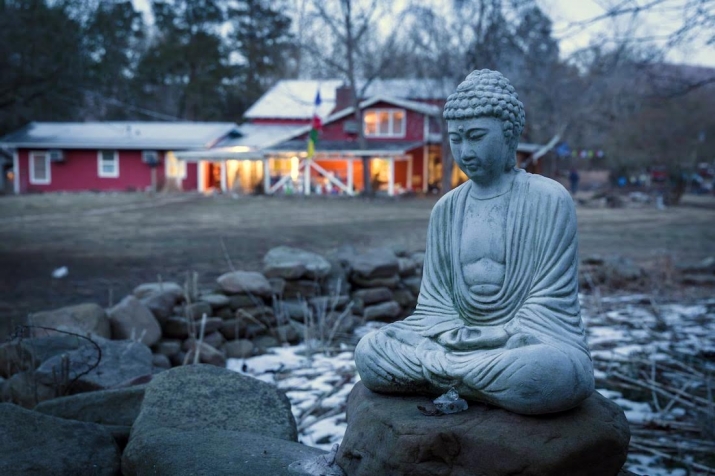 Current temple and sangha house. Image courtesy of Katog Choling Mountain Retreat Center
Current temple and sangha house. Image courtesy of Katog Choling Mountain Retreat CenterSome eight miles (13 kilometers) outside of Jasper, a small town in the Ozark Mountains of Arkansas, a new Tibetan Buddhist community is taking root. The Katog Choling Mountain Retreat Center, initially incorporated as a non-profit in Louisiana in 2005, spans 400 breathtaking tree-filled acres (162 hectares), complete with meditation caves.
The center’s founder, Khentrul Lodro Thaye Rinpoche, first arrived in the United States in 2002 at the invitation of the renowned teacher Chagdud Tulku Rinpoche for the purpose of teaching a shedra—a traditional school for studying Buddhist philosophy. Over the past 14 years, Rinpoche and his translator Paloma Lopez Landry have tirelessly traveled throughout the country, giving public talks and establishing relationships that have grown into a network of 20 practice centers. Khentrul Rinpoche is from the traditional Tibetan region of Amdo, and is a holder of the Katog lineage from the Nyingma tradition. Rinpoche has also earned three khenpo degrees (equivalent to a PhD in Buddhist philosophy), the first of which was under his root teacher His Holiness Khenpo Jigmey Phuntsog Rinpoche at Larung Gar Buddhist Academy.
In addition to Katog Choling, Rinpoche is responsible for a monastery in Amdo, as well as an orphanage there that offers the children a traditional Tibetan education.
Through Rinpoche’s translator, Paloma, I interviewed Rinpoche about his plans for the new site in Arkansas and how he sees Buddhism in America.
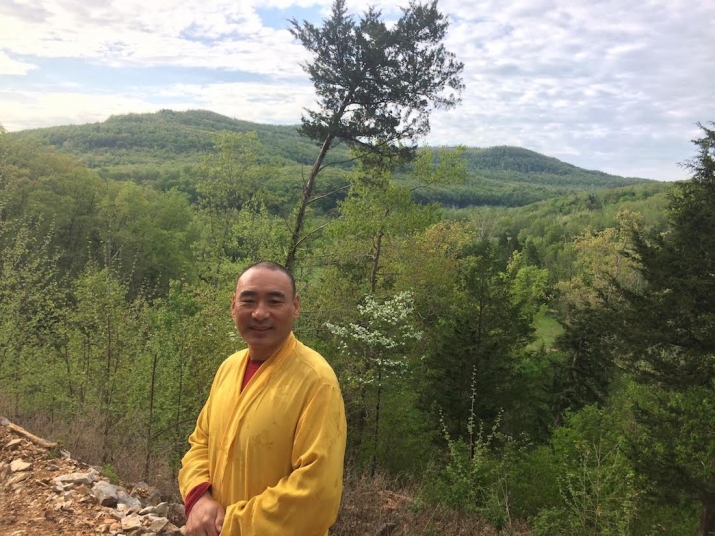 Khentrul Rinpoche. Image courtesy of Katog Choling Mountain Retreat Center
Khentrul Rinpoche. Image courtesy of Katog Choling Mountain Retreat CenterBuddhistdoor Global: Rinpoche what is your intention for the land, the creatures, rivers, and trees who live there, your students, and the surrounding neighbors?
Khentrul Rinpoche: My intention for this retreat land is that it be a place for the pure and authentic Dharma to spread. By providing this place, practitioners have an opportunity to study (hear teachings), contemplate, and meditate on the Dharma in a traditional manner, as well as to do more intensive practice in retreat. The people who can study and practice in an undiluted approach will then be able to spread that traditional study and practice to others here and, in turn, to other places and throughout the world. This is my aspiration for establishing this retreat land.
Living on and caring for the land provides an example of living in harmony with the environment that supports us, and our responsibility to care for the Earth. If we have to cut down trees, for example, we will plant new ones in another place. By living sustainably, not only are we in harmony with the environment, we also provide an example of a sustainable culture of living that doesn’t destroy the land we live on, but rather cares for and improves it.
Our neighbors have been very open-minded and gracious. In turn, we have the intention to be good neighbors to others and to use that interaction as a basis for compassion in action. If anyone we know of is in need, we will try to help. This is a poor area and we want to be a support to those around us. One way in which I envision this is by building a wellness center that can provide those in the area with alternative modalities of healthcare, especially Tibetan medicine. We would like to provide a space for wellness with different healing modalities to those who would otherwise not have an opportunity to get such treatments and who cannot afford it. So in the future, hopefully, we will be able to give more to the community in this way as well.
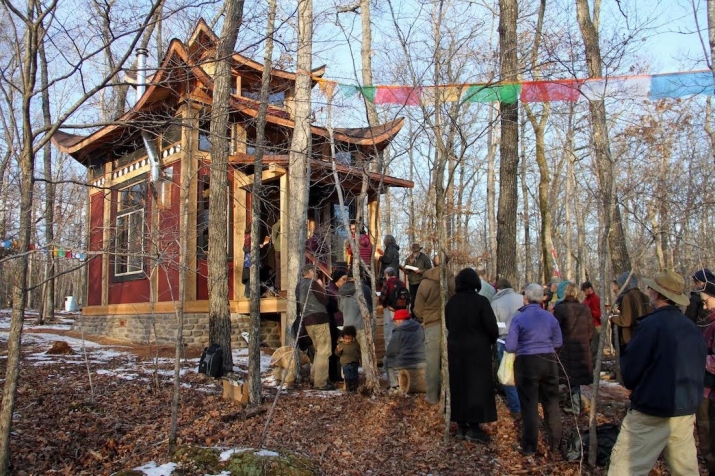 Retreat center. Image courtesy of Katog Choling Mountain Retreat Center
Retreat center. Image courtesy of Katog Choling Mountain Retreat CenterBDG: What were your thoughts when you first visited the land?
KR: The first time I came, it was late in the afternoon. Because there are so many trees, it seemed a little dark in the valley. But the next morning when the sun rose and I was able to look at it carefully, I saw many wonderful things. It felt as if, with the rising sunlight, the light rays of my mind illuminated its many qualities.
I also remember that a local resident gave me a walking stick. In Tibet, we consider that a sign of interdependence for the future. It indicated to me that I would live here a long time and would still be walking the land when I get old and need a walking stick.
BDG: Would you speak about your motivation behind the “Compassion Action” your American students are undertaking, and what you feel the benefits are, specifically to the US?
KR: There are many who criticize Buddhism, thinking that its only focus is sitting on a cushion and quieting the mind or doing prayers. They think it means inaction. I get many questions about this. However, while there is the formal training of focusing on taming the mind, the primary purpose of this is to grow our capacity to benefit others. The ultimate aim is for the welfare of all sentient beings. So I felt that it was important to demonstrate taking our practice into action. Both the intention and actions should be for the benefit of others. When we look at Buddhist conduct, it is based on the six perfections [paramitas], such as generosity and the ethical discipline of doing no harm. As well, there are numberless practices based on love and compassion and it is important to learn how to translate our intention into action, as conduct is an indispensable component of practice.
Since coming to the US, I have witnessed many changes in this country and the world. It became evident to me that actively engaging in one’s community and country to help others is very important. Likewise, doing so as a group is much more powerful than just as one person. I have over 20 practice groups across the country and I ask that each do two community outreach projects each year. It is a way to learn how to take our practice and put it into action. The first project we did as one group was raising funds for a remote village in Nepal called Langtang, which had been wiped out by an avalanche in a recent earthquake. It was very inspirational as an initial project, but the main focus for each group is finding projects in their local community. It is my hope that this will be of benefit to the practitioners and help others in their community, and also serve as an example for other Buddhist groups and organizations of how to come together and help each other.
I think that this kind of action has a ripple effect of benefiting people on a personal level, expanding to the community, and helping the country. Our projects are broad ranging, depending on whatever a group sees as a need in their community. It could be helping a sick person or the homeless, visiting old folks homes, cleaning the yard of an elderly neighbor, volunteering to help at an animal shelter, saving abused animals, or cleaning up garbage at a local park or beach. These projects are enriching for those who do them, directly helping the people affected by them, building the community, and protecting the environment. The benefits are vast.
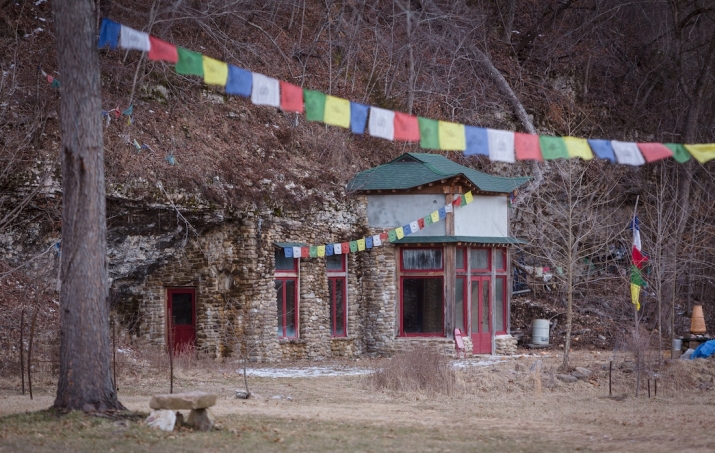 Cave temple at Losar. Image courtesy of Katog Choling Mountain Retreat Center
Cave temple at Losar. Image courtesy of Katog Choling Mountain Retreat CenterBDG: Why do you think Americans are responding so dramatically to Buddhism and how do you see the future of the Dharma in the US?
KR: Definitely there is a growing enthusiasm for Buddhism in America. The reasons are numerous, but one of them I think is the science- and logic-oriented culture of the 21st century, especially here in the US. People want to have logical reasons and evidence in order to believe in something. This is an era of many questions and investigations. This is why the scientific view is so strong in the West. The Buddhist path is an evidence-based philosophy that uses logic and reasoning. We are not taught to simply accept and believe; rather critical thinking is encouraged. In fact, if we don’t study enough and lack knowledge, faith alone is not sufficient to progress on the path. This is one reason I think Buddhism is so compatible with Western culture and is growing in popularity.
Also, that knowledge is then intended to be put into practice so that we directly experience it. For example, if we train in love and compassion, we are the direct recipients of their beneficial effects. So it is a path based on cultivating logical wisdom and personal experience. I think these are the main reasons it is spreading so rapidly and I think it will continue to grow in the future and benefit many people.
Also, while those who are able to fully engage in and practice the complete Buddhist path will obviously experience benefits, there are many tools within Buddhist philosophy and practice that are universal to others as well. I think that as these techniques are spread more universally, it will help many people and benefit society as a whole.
The wellness center is a separate property of 28 acres (11 hectares) up the road from the retreat center. We would like to provide a place for wellness and health retreats where practitioners can treat people using such as Tibetan medicine, acupuncture, massage, and other modalities, and provide seminars for training and education.
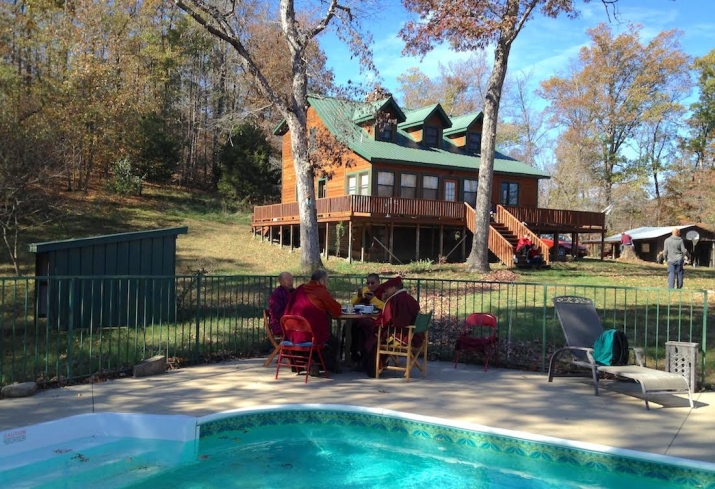 Wellness Center. Image courtesy of Katog Choling Mountain Retreat Center
Wellness Center. Image courtesy of Katog Choling Mountain Retreat CenterBDG: What are your future plans for the wellness center?
KR: When I first came to America, I learned a lot about the medical system here and in other developed countries. What I saw was a great disparity between the wealthy and the poor in relation to healthcare. It seems that those with money have many opportunities to receive different healthcare modalities, while those who are poor lack such resources. Poor people are more likely to die due to a lack of good medical support and also suffer from more treatable ailments. I envision creating a wellness center that provides affordable alternative healthcare modalities to people in our local area, many of whom are quite poor. The center will not be based on a for-profit model, but rather provide a space for receiving treatments at reduced rates, just enough to cover our costs. It is my aspiration that this project grows and becomes a real resource and benefit to people’s health and wellbeing.
BDG: What are your suggestions as we move into the coming year?
KR: I think the next year will see many changes. Some countries may experience development while others fall onto many hardships. However, my advice during this time is that no matter what occurs, whether happiness or suffering, as human beings it is crucial that we adhere to a kind heart and positive, noble actions. Never let those deteriorate, no matter what challenges we face in our own countries and on Earth; we cannot let these be lost.
See more
















